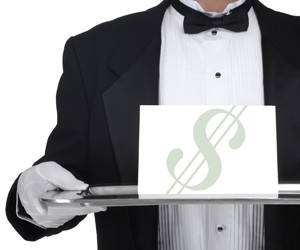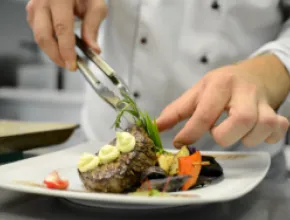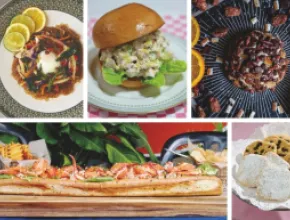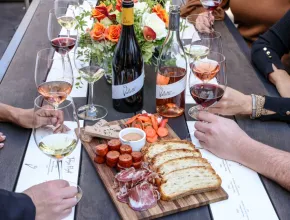When planning a banquet—or a range of food and beverage events over the course of an event—on a budget, one’s first instinct might be to order the chicken versus the steak, buffet versus plated, and take other basic steps to keep costs low.
But experienced planners say such measures aren’t the way to save money and still have a successful event. In other words, those steps leave attendees hungry for more.
Rather, they contend, meeting organizers who pay attention to both general and industry trends, listen to the needs of both suppliers and attendees and think creatively will be able to hit their budget without looking like they did things on the cheap.
Here’s the advice some veteran planners dished out:
 Joan Eisenstodt
Joan Eisenstodt
Chief Strategist
Eisenstodt Associates LLC
At the time the RFP is sent, ask for a link to the venue’s menus or, if they are paper-based, for a copy. Know at the outset, before selecting a venue, what the food and beverage prices look like.
Ask the venue how their food prices have fluctuated in the last few years and what they expect. Food prices have gone up so we have to budget for that and explain to clients.
Talk with the chef at the start of things and when planning the event. (S)he will have great ideas for what you can do on your budget, and be realistic about what costs are, even on labor, and where they can and cannot make cuts. You don’t just want the food to look good, it’s also about the service.
If your group can live without dessert at a meal, serve an equivalent at a break instead. It saves money and calories, and it’s appreciated.
Required, or prefer, to be a “locavore” [use local products]? Ask if that saves money—or saves on the meeting’s carbon footprint.
Labor charges, service charges, gratuities and taxes often add greatly to the cost of F&B. They are usually not negotiable, but ask!
Provide your entire F&B budget and a list of exactly what the functions will entail. For example, 15 for a continental breakfast (and say what you think that includes), 125 for a three-course lunch, 75 for each of x breaks (and what you expect at those), etc. Note, if your budget includes “++” or sometimes “+++,” the chef can work with you to move your budget around.
Make no assumptions even among hotel brands. Not all menus include the same things nor are their policies the same.
Ask “what can we do that will cost less but make people feel full, that will make the plates look nice?” When people see something little come out, psychologically they don’t feel full.
 Arlene Sheff, CMP
Arlene Sheff, CMP
Strategic Meeting Consulting
Most groups enjoy burgers and hot dogs if they are cooked outdoors on a grill. That’s probably one of the lower-cost buffets because the items are cooked to order so there’s not as much waste on the meat.
Add picnic-type salads and chips—which the hotel can reuse if they’re not eaten—and apple pie and/or brownies for dessert and most people are very happy.
Instead of boxed lunches, do a “to go lunch.” I did this for a group of executives who were on their way to the airport; I hate boxed lunches because someone always gets the oatmeal cookie or the wrong bread. Instead, I got sandwiches wrapped by the half, I bought the sandwiches but ordered drinks and chips on consumption, served wrapped cookies and everyone put what they wanted in their bag.
I got 1,000 executives out of the hotel in 20 minutes.
Know F&B pricing before the hotel contract is signed.
The best leverage is to know demographics (men/women, age, where they’re from, ethnicity, salary range, age range, etc.) of your group and how much they eat.
Learn how to compare purchasing methods—i.e. continental breakfast per person or “in bulk” (coffee by the gallon, Danish/bagels by the dozen, etc.)—and also do the same thing for receptions.
Know the best purchasing method of alcohol for your group; i.e. per drink, per bottle, per person/per hour, etc.
Give accurate guarantees, which may be affected by what the group did the night before, who is speaking at breakfast, what distractions are close by them, speakers may not attend lunch if they are presenting right after lunch—recheck with them.
Linda Peters
Sales Office Administrator
Varian Medical Systems
Request a lunch-sized portion at a plated dinner. Usually dinners are multiple courses so attendees don’t even notice. As far as venues going along, it’s a 50/50 thing.
Have salad rather than soup as a starter; it saves on service. Also, more people eat salad but soup is trickier.
Venues and hotels are willing to work with you, especially with the chefs because they love to be creative; they love what they do and want to show off what they can do.
They always know what’s in season. If it’s mid-October and I want peaches, they’re not in season but they can substitute kiwi, which is in season. So if the hotel is willing to let the chef in on the conversation, you wind up with a better menu.
 Lancey Cowan
Lancey Cowan
Assistant Director of Meetings
Association for Research in Vision and Ophthalmology
If you are doing a lunch and afternoon break, hold the dessert from lunch and serve it for the afternoon snack. We have done that a lot for full-day, small conferences. It saves at least 25 percent.
Also, for our annual meeting, we may have six committees meeting during breakfast. We used to do a continental breakfast but now we do a buffet and have groups meet in close proximity. We under-guarantee on the buffet and the building has less labor because it’s not doing six different set-ups. Normally, I under guarantee by 5 percent to 10 percent. It’s a 20 percent savings and we still have food left over.
And they don’t count plates, they just charge us for what we guaranteed. If a venue is going to count plates, you can’t do much, but maybe they’ll lower menu prices with buffet versus continental.
We keep a record of how much food we have left over and we can use that information the following year to order less food.
We have a requirement in our banquet event order for the venue to keep a record of how much we’ve left over.
With hotels, I have looked at menus a little out of our price range and asked the catering manager or chef if they could come up with some alternatives.
 Marge Risinger, CMP
Marge Risinger, CMP
Consultant
MYR Consultants
Know all of the menus in the hotel, room service, the cafe, etc. That way you can compare to the banquet prices [even though you need to remember that banquet prices are usually higher because of the private room and staff, etc.]
Many years ago, I was planning a meeting and the banquet price for orange juice by the gallon was $72.00++ but the room service price was $2.50 per glass. It takes more service for room service so my negotiation point was if I didn’t get a lower price, I would call room service and order 900 glasses of orange juice. The hotel matched the room service price.
For a four-hour event, do a two-hour bar package and then run the balance of the evening charging per drink. This works because most guests will consume more in the first two hours as guests start to leave after that time.
If you provide entertainment, not background music, guests tend to stop eating and drinking and watch the show. Also, avoid salty foods; salt makes people thirsty.
Order “dead-stock wine.” When a new catering manager comes into the hotel he or she usually develops a new wine list. The wine leftover from the last catering manager is still good but is not on the new wine list.
Ordering a “dead-stock wine” can save you 50 percent off regular wine prices. Just remember that those wines are not always plentiful, you may have to serve different kinds for a large group. Also, if you are hesitant about the quality, buy a bottle and taste it.
Replace a hosted bar with drink tokens. When I’ve done this, I order plastic coins with the company logo on them and give each participant seven tokens for the opening reception and closing banquet.
The biggest savings of all came when guests went to dance; they put down their drinks.






